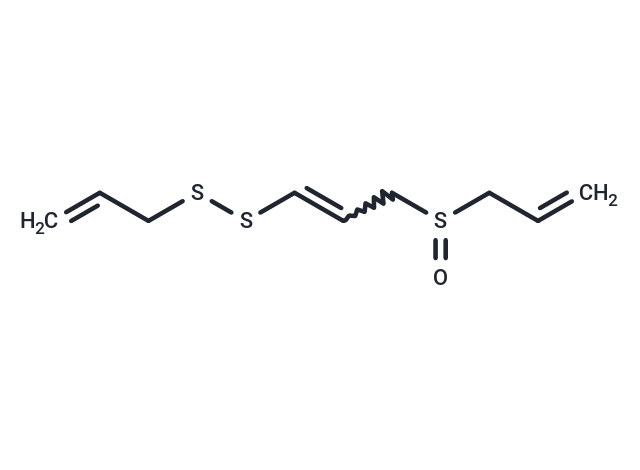- Remove All
 Your shopping cart is currently empty
Your shopping cart is currently empty
Ajoene
Ajoene is a disulfide that has been found inA. sativumand has diverse biological activities, including antibacterial, anticancer, antiplatelet, and antioxidant properties.1,2,3,4It is active against Gram-positive (MICs = 5-160 µg/ml) and Gram-negative bacteria (MICs = 136-200 µg/ml), as well as yeasts (MICs = 10-20 µg/ml).1Ajoene is cytotoxic to mouse melanoma cells (IC50= 18 µM), as well as human colon, lung, mammary, and pancreatic cancer cells (IC50s = 7-41 µM).2It reduces tumor growth in a B16/BL6 mouse model of melanoma when administered at a dose of 25 mg/kg every other day and decreases the number of lung metastases when administered prior to tumor cell inoculation at doses ranging from 1-25 mg/kg. It inhibits ADP- or collagen-induced platelet aggregation in isolated baboon platelets when used at concentrations ranging from 75 to 150 µg/ml and in platelet-rich plasma isolated from baboons when administered at a dose of 25 mg/kg.3Ajoene (25 mg/kg) prevents thrombus formation on damaged arterial walls in heparinized pigs in anin situmodel of thrombogenesis.5It also reduces high-fat diet-induced hepatic steatosis, histopathological markers of liver damage, thiobarbituric acid reactive substances (TBARS) formation, and protein oxidation in a mouse model of non-alcoholic fatty liver disease (NAFLD).4

Ajoene
| Pack Size | Price | Availability | Quantity |
|---|---|---|---|
| 10 mg | $2,558 | Backorder |
Product Introduction
| Description | Ajoene is a disulfide that has been found inA. sativumand has diverse biological activities, including antibacterial, anticancer, antiplatelet, and antioxidant properties.1,2,3,4It is active against Gram-positive (MICs = 5-160 µg/ml) and Gram-negative bacteria (MICs = 136-200 µg/ml), as well as yeasts (MICs = 10-20 µg/ml).1Ajoene is cytotoxic to mouse melanoma cells (IC50= 18 µM), as well as human colon, lung, mammary, and pancreatic cancer cells (IC50s = 7-41 µM).2It reduces tumor growth in a B16/BL6 mouse model of melanoma when administered at a dose of 25 mg/kg every other day and decreases the number of lung metastases when administered prior to tumor cell inoculation at doses ranging from 1-25 mg/kg. It inhibits ADP- or collagen-induced platelet aggregation in isolated baboon platelets when used at concentrations ranging from 75 to 150 µg/ml and in platelet-rich plasma isolated from baboons when administered at a dose of 25 mg/kg.3Ajoene (25 mg/kg) prevents thrombus formation on damaged arterial walls in heparinized pigs in anin situmodel of thrombogenesis.5It also reduces high-fat diet-induced hepatic steatosis, histopathological markers of liver damage, thiobarbituric acid reactive substances (TBARS) formation, and protein oxidation in a mouse model of non-alcoholic fatty liver disease (NAFLD).4 1.Naganawa, R., Iwata, N., Ishikawa, K., et al.Inhibition of microbial growth by ajoene, a sulfur-containing compound derived from garlicAppl. Environ. Microbiol.62(11)4238-4242(1996) 2.Taylor, P., Noriega, R., Farah, C., et al.Ajoene inhibits both primary tumor growth and metastasis of B16/BL6 melanoma cells in C57BL/6 miceCancer Lett.239(2)298-304(2006) 3.Teranishi, K., Apitz-Castro, R., Robson, S.C., et al.Inhibition of baboon platelet aggregation in vitro and in vivo by the garlic derivative, ajoeneXenotransplantation10(4)374-379(2003) 4.Han, C.Y., Ki, S.H., Kim, Y.W., et al.Ajoene, a stable garlic by-product, inhibits high fat diet-induced hepatic steatosis and oxidative injury through LKB1-dependent AMPK activationAntioxid. Redox Signal.14(2)187-202(2011) 5.Apitz-Castro, R., Badimon, J.J., and Badimon, L.A garlic derivative, ajoene, inhibits platelet deposition on severely damaged vessel wall in an in vivo porcine experimental modelThromb. Res.75(3)243-249(1994) |
| Molecular Weight | 234.39 |
| Formula | C9H14OS3 |
| Cas No. | 92285-01-3 |
| Relative Density. | 1.181 g/cm3 (Predicted) |
| Storage | Powder: -20°C for 3 years | In solvent: -80°C for 1 year | Shipping with blue ice. |
| Solubility Information | Methanol: Slightly soluble Chloroform: Slightly soluble Ethyl Acetate: Slightly soluble |
Calculator
In Vivo Formulation Calculator (Clear solution)
Dose Conversion
Tech Support
Keywords

Copyright © 2015-2024 TargetMol Chemicals Inc. All Rights Reserved.




